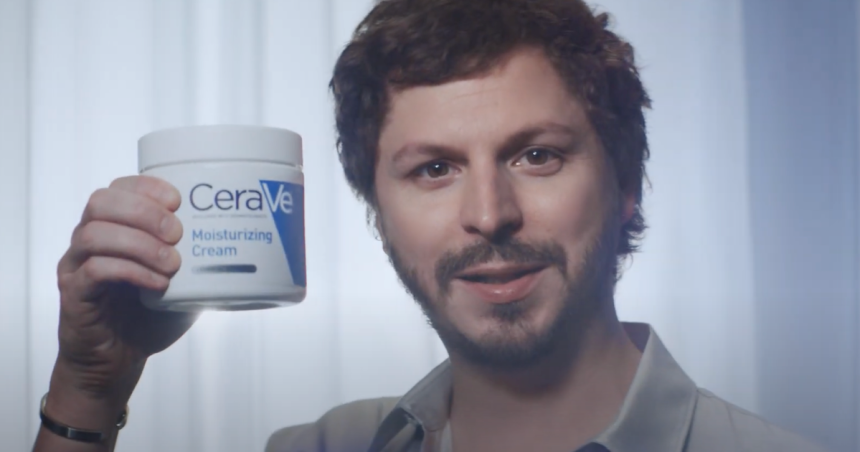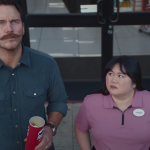It all started with a bag of lotion.
Or two, actually. When Michael Cera was photographed walking down the street with a bunch of CeraVe skin-care products in hand last month, people immediately asked, “Why?”
That same day, creator Haley Kalil posted a video of Cera at a pharmacy, where he was writing his first name on bottles of CeraVe. (Michael Cera..Ve. Get it?) Then influencers started posting gift boxes with Cera’s face on them, and creator and podcaster Bobbi Althoff interviewed Cera, during which he walked off set when asked whether he was behind the brand.
CeraVe “set the record straight” in an Instagram post, denying claims of Cera’s involvement, and some influencers posted paid apology videos to clear up any confusion around whether Cera created CeraVe. Creator Caleb Simpson then posted a “tour” of Cera’s trailer, which was filled with skin-care products, and dermatologist Dr. Shah posted a TikTok “confronting” Cera about his skin-care expertise.
This week, a website featuring Cera and the tagline “Human skin is his passion” rolled out, as did a teaser video for what some people correctly predicted to be CeraVe’s first-ever Super Bowl commercial.
Ahead of the game, we spoke with Melanie Vidal, global brand manager for CeraVe at L’Oréal, about the strategy behind the campaign and its faux-organic lead-up.
This interview has been edited and condensed for clarity.
I want to talk about the lead-up to the Super Bowl campaign because of how organic it seemed and how much that’s driven buzz, from the pharmacy run-in to the paparazzi pics. I’ve even seen some creators posting paid videos speculating about what all this means. Tell me about that strategy and how you guys came up with it.
Before you go into these disruptive marketing campaigns, you never know whether they’re gonna be a hit or not. Our ambition for the Super Bowl campaign was really to create a first-of-its-kind, disruptive campaign that invites everyone to participate in a story we’re creating where, to your point, you create a sort of fake-news phase, then you have a debunking phase, and then you have the revelation phase. It’s a three-phase campaign.
The idea was to lean into what already existed because Michael Cera being the person behind CeraVe was something that popped up on social media and was already driving conversation and had a very positive sentiment around it, so we thought we could bring that to another level and really use that as our springboard to say that we’re not developed by a celebrity, but with dermatologists…A lot of skin-care brands created by celebrities are popping up today; it feels like every celebrity has their own skin-care brand, and so we wanted to lean into that as well.
How has the audience reception been? Do you feel like it’s driving as much buzz as you wanted?
We’re quite excited with the buzz that it’s creating. In terms of quantity, we have very big impression numbers and views, but also engagement. But what I think we love the most is the comments that we’re seeing. Above and beyond awareness and engagement, just the sheer love that we’re getting is really what impresses us most, and the fun that people are getting out of it.
You mentioned that the Michael Cera-CeraVe jokes have kind of existed for years online. Did the inspiration for this partnership stem from social listening, and if so, do you feel like that’s contributing to why this is resonating well?
I think it’s totally part of it. Obviously, it’s been fleshed out in a much more ambitious way, but everything that we do at CeraVe stems from social listening. And we work with influencers in a very authentic way in the sense that most of the influencers we work with, whether they’re derm influencers or skin influencers, big or small, are authentic users of the brand. Like Charlie D’Amelio, the first time she talked about CeraVe was organically, because she loved the product. Even Emma Chamberlain, when she talked about CeraVe, she had been using it since she was 11, because she has atopic skin and her derm had recommended it to her. Even Dr. Shah was recommending CeraVe, because when he was in med school, his mentor was recommending CeraVe. So they all have a preexisting relationship with the brand. And we like to work in this way because I think that’s what bridges the trust gap today on social media and what creates more authentic and engaging content.
Get marketing news you’ll actually want to read
Marketing Brew informs marketing pros of the latest on brand strategy, social media, and ad tech via our weekday newsletter, virtual events, marketing conferences, and digital guides.
A lot of brands put out a teaser of the ad they’re going to air on TV, but this buildup was a lot more organic-seeming. Do you feel like this strategy paid off and was better than just releasing a snippet of the final ad?
I think it did. It’s a question of point of view, but the reason why I think it did is because today, when you look at the [Meltwater] ranking in terms of share of voice for Super Bowl lead-up, we are the No. 1 beauty brand. And I guess it’s thanks to this buzz that we created because, as you know, we didn’t even say we were going to the Super Bowl until February 7. It was never quoted in any of the comments or content that we’ve been releasing, everybody just assumed we would. So I think people decoded much more than we think and I feel like it paid off in the sense that now people are anticipating what’s going to be next. Whereas when you just announce it, you’re just one of many brands.
More beauty brands seem to be getting in on the Super Bowl each year. So why did CeraVe decide to get involved this year?
First, it’s the biggest, most anticipated, and most disruptive advertising stage in the world, and we felt like we were at that level of audience and engagement that would make us legitimate to get to that stage because we already have 1.4 million TikTok followers, on #CeraVe we have 9 billion views. Where could we meet an even wider audience in a disruptive way? It felt like the Super Bowl was the perfect rendezvous for that. And we’re a brand that stands for therapeutic skin care for all, and “for all” means from cradle to grave, for all age groups, all ethnicities, all communities, and it’s a genderless brand.
Beauty brands so often are associated with women. By advertising in the Super Bowl and also working with a male celebrity, was this a way of making it clear that skin care is gender-neutral and appealing more to a male audience?
Totally. We already have a good portion of male consumers…skin issues are genderless. But it’s exactly what you said, it’s because in the advertising realm, beauty brands tend to be very much focused on a female audience. We wanted to spin this on its head and go for the bigger, wider Super Bowl play with a male main character and really make it clear that it’s a wider-audience brand. We worked with influencers across ages, communities, gender…And we also worked with another type of influencer this time, news breakers who decoded the rumors online. That also allowed us to widen our audience because it put us in outlets where we never used to be and where skin-care brands are usually not spoken of.
How long did this campaign take to pull together?
We worked on this for six months, at least, if not more.
Did Michael Cera have a say in the creative or was that mostly up to the teams at WPP and Tim & Eric, who worked on the ad? It felt like the narwhal was Cera’s brand of humor.
It’s a partnership. But we tend to lean into the creative people we work with. That’s our philosophy. Even when we create content on social media, we lean into the creative spirit of the content creators we work with because we feel like they know their audience best and they know what is interesting…I feel that if we don’t lean into this creativity, we tend to manufacture too much corporate content, and not enough engaging storytelling.
What do you hope the ultimate impact of this ad is after the game?
Hopefully, people will know that CeraVe exists, so, awareness. That CeraVe is developed with dermatologists, not Michael Cera. And that is a serious but fun, safe skin-care brand that is for everyone, that they want to check out and try…We do want to become the skin-care staple brand as much as all of the other brands who are in the Super Bowl are the staple of their own categories.
Read the full article here










